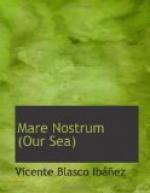Certain red letters on the walls were announcements of elections to be held in the beginning of that era,—candidates for aedile or duumvir who were recommended to the Pompeiian voters. Some doors showed above, the phallus for conjuring the evil eyes; others, a pair of serpents intertwined, emblem of family life. In the corners of the alleyways, a Latin verse engraved on the walls asked the passerby to observe the laws of sanitation, and there still could be seen on the stuccoed walls caricatures and scribbling, handiwork of the little street gamins of Caesar’s day.
The houses were lightly constructed upon floors cracked by minor earthquakes before the arrival of the final catastrophe. The lower floors were of bricks or concrete and the others, of wood, had been devoured by the volcanic fire, only the stairways remaining.
In this gracious city of amiable and easy-going life, more Greek than Roman, all the lower floors of the plebeian houses had been occupied by petty traders. They were shops with doors the same size as the establishment, four-sided caves like the Arabian zocos whose furthermost corners were visible to the buyer stopping in the street. Many still had their stone counters and their large earthen jars for the sale of wine and oil. The private dwellings had no facades, and their outer walls were smooth and unapproachable, but with an interior court providing the surrounding chambers with light as in the palaces of the Orient. The doors were merely half-doors of escape, parts of larger ones. All life was concentrated around the interior, the central patio, rich and magnificent, adorned with fish ponds, statues and flower-bordered beds.
Marble was rare. The columns constructed of bricks were covered with a stucco that offered a fine surface for painting. Pompeii had been a polychrome city. All the columns, red or yellow, had capitals of divers colors. The center of the walls was generally occupied with a little picture, usually erotic, painted on black varnished walls varied with red and amber hues. On the friezes were processions of cupids and tritons, between rustic and maritime emblems.
Tired of his excursion through the dead city, Ferragut seated himself on a stone bench among the ruins of the temple, and looked over the map spread out on his knees, enjoying the titles with which the most interesting constructions had been designated because of a mosaic or a painting,—Villa of Diomedes, the House of Meleager, of the wounded Adonis, of the Labryinth, of the Faun, of the Black Wall. The names of the streets were not less interesting: The Road of the Hot Baths, the Road of the Tombs, the Road of Abundance, the Road of the Theaters.
The sound of footsteps made the sailor raise his head. Two ladies were passing, preceded by a guide. One was tall, with a firm tread. They were wearing face-veils and still another larger veil crossing behind and coming over the arms like a shawl. Ferragut surmised a great difference in the ages of the two. The stout one was moving along with an assumed gravity. Her step was quick, but with a certain authority she planted on the ground her large feet, loosely shod and with low heels. The younger one, taller and more slender, tripping onwards with little steps like a bird that only knows how to fly, was teetering along on high heels.




